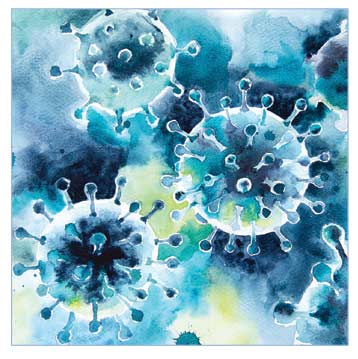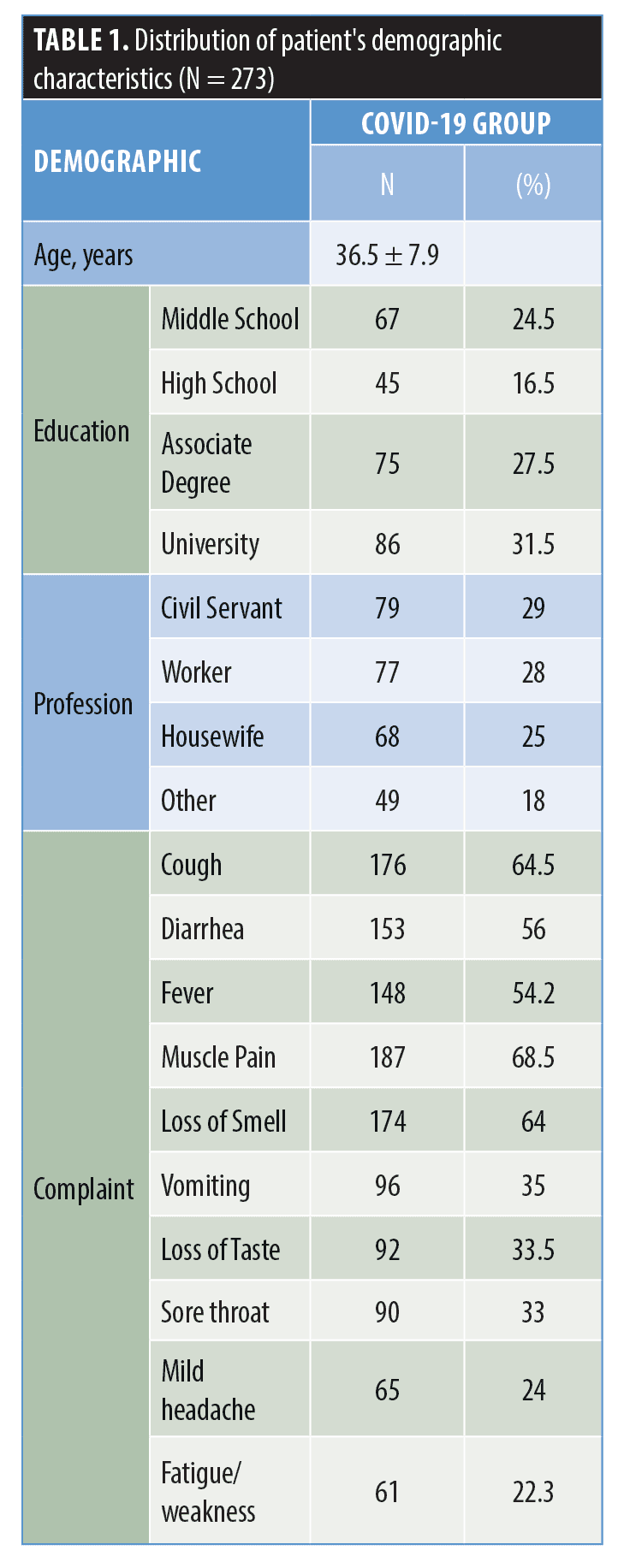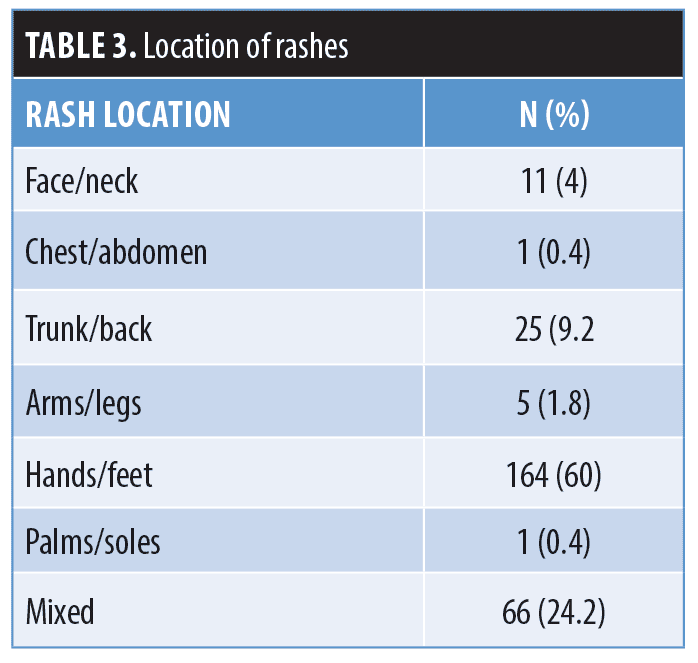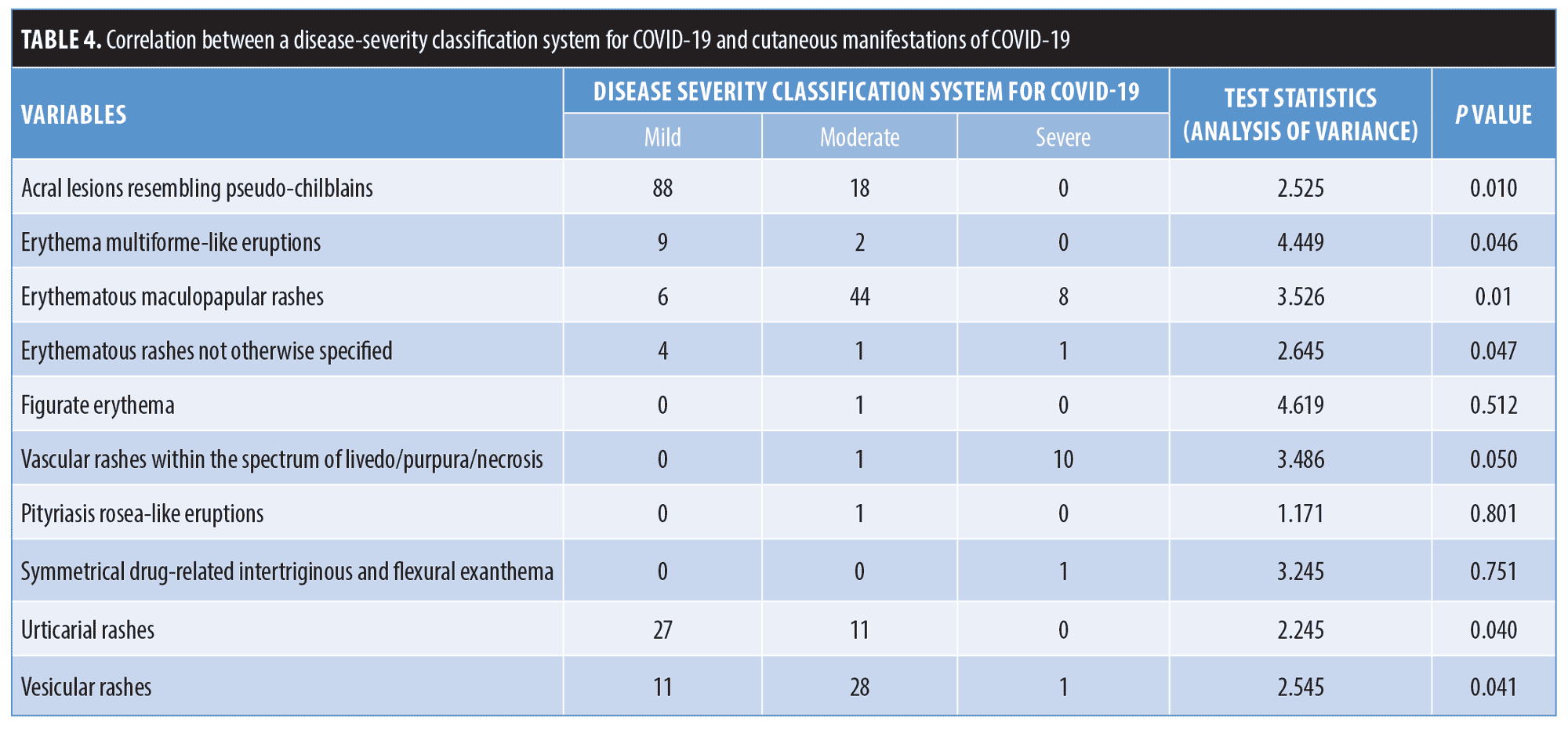 J Clin Aesthet Dermatol. 2022;15(5)
J Clin Aesthet Dermatol. 2022;15(5)
Drs. Mohammed and Atef are with the Department of Dermatology and Venereology, Faculty of Medicine at the Suez Canal University in Ismailia, Egypt. Dr. Al-Dhubaibi is with the Department of Dermatology, College of Medicine at Shaqra University in Dawadmi, Saudi Arabia.
by Ghada Farouk Mohammed, MD; Mohammed Saleh Al-Dhubaibi, MD; and Lina Atef, MD
FUNDING: No funding was provided for this article.
DISCLOSURES: The authors report no conflicts of interest relevant to the content of this article.
ABSTRACT: Background. Although the severe acute respiratory syndrome coronavirus 2 (SARS-CoV-2) is primarily responsible for respiratory symptoms, an increasing number of cutaneous manifestations have been reported. Cutaneous manifestations are reported by patients following disease recovery.
Objective. We sought to document various skin lesions relating to COVID-19 symptoms either before, during, or after infection with severe acute respiratory syndrome coronavirus 2.
Methods. This was a descriptive study with 273 patients who had cutaneous manifestations after recovering from COVID-19. Each patient provided a thorough medical history and underwent a general physical examination. Following polymerase chain reaction analysis, all participants were confirmed to be COVID-19 patients.
Results. Acral lesions were the most common, accounting for 39% of all cases. An erythematous maculopapular rash was found in 21% of cases and was the second most common after urticaria, with fewer cases of erythema multiform, vesicular rash (9%), vascular livedo reticularis, figurate erythema, and flexural rash documented.
Conclusion. The most common cutaneous changes seen in patients with COVID-19 were pseudo-chilblain acral lesions, which had a good prognosis. Vascular rashes within the spectrum of livedo/purpura/necrosis were seen with severe forms of COVID-19.
Keywords: Coronavirus, COVID-19, cutaneous manifestations, skin
Coronavirus disease 2019 (COVID-19) is a highly contagious respiratory tract infection caused by severe acute respiratory syndrome coronavirus 2 (SARS-Cov-2). First reported in Wuhan, China, on December 1, 2019, COVID-19 has since caused a global pandemic.1
COVID-19 is spread by virus-infected droplets and contaminated objects. The infection incubation period ranges from 2 to 14 days, with an average incubation of five days.2 COVID-19 has been linked to symptoms such as fever, cough, sore throat, shortness of breath, muscle pain, nausea, diarrhea, and loss of taste and smell.3 Organ dysfunction, progressive respiratory failure, and coagulation disorders—all of which are associated with a high mortality rate—have also been reported.4
COVID-19 brings up a number of critical issues in dermatology and dermatologic care.5 Urticarial, maculopapular, papulovesicular, purpuric, livedoid, and thrombotic ischemic lesions have all been reported as cutaneous manifestations of the infection.6 On the other hand, the reported cutaneous manifestations of COVID-19 are diverse, dispersed, and occasionally perplexing.
Although cutaneous manifestations of COVID-19 are uncommon, all clinicians should be aware of them because they may contribute to an earlier and better diagnosis and management of the disease, even in asymptomatic or pauci-symptomatic patients. This could be a valuable aid in disease epidemiological control, particularly in areas where diagnostic kits are scarce.7 As a result, we intend to investigate various skin lesions concerning COVID-19 symptoms either before, during, or after infection with COVID-19.
Methods
Study design and patient population. This descriptive study was carried out following the Declaration of Helsinki guidelines after receiving approval from an institutional review board. Patients were recruited from a tertiary hospital between December 2020 and July 2021. A written informed consent form was signed by each participant. Women who had completed the management protocol had been released for ≥2 weeks. Each patient provided a detailed medical history and underwent a general physical examination. Following polymerase chain reaction analysis, all participants were confirmed to be COVID-19 patients, as evidenced by their medical reports.
Statistical analysis. For data analysis, SPSS version 20 (IBM Corporation, Armonk, New York) was used. Quantitative data are presented as mean ± standard deviation (SD) values and qualitative data are presented as percentages and frequencies. Shapiro–Wilk analysis was performed to examine conformance to the normal distribution. A paired t-test was used to compare data with a normal distribution, while the Wilcoxon test was used to compare data that did not have a normal distribution. For data that did not follow a normal distribution, a median (minimum–maximum) was used P<0.050 was deemed statistically significant.
Results
Patients’ average age was 36.5 ± 7.9 years, and over 90 percent of patients reported coughing, 68.5 percent reported muscle pain, 64 percent reported a loss of smell, 56 percent reported diarrhea, 54.2 percent reported fever, 35 percent reported vomiting, 33.5 percent reported a loss of taste, 33 percent reported a sore throat, 24 percent reported a mild headache, and 22.3 percent reported fatigue/weakness (Table 1).

The characteristics of the cutaneous symptoms described in COVID-19 patients are summarized in Table 2. These categories included acral lesions resembling pseudo-chilblains, erythema multiforme-like eruptions, erythematous maculopapular rashes, erythematous rashes not otherwise specified, figurate erythema, vascular rashes within the spectrum of livedo/purpura/necrosis, pityriasis rosea-like eruptions, symmetrical drug-related intertriginous and flexural exanthema, urticarial rashes, and vesicular rashes. Acral lesions resembling pseudo-chilblains totaled 39 percent of cutaneous manifestations and mostly occurred at a young age. Acral lesions appeared in 64 percent of patients after the onset of COVID-19.
Acral lesions were the most common category identified (39% of all cases), followed by erythematous maculopapular rashes (21.1%), vesicular rashes (15%), urticarial rashes (14%), vascular rashes within the spectrum of livedo/purpura/necrosis (4%), erythema multiforme-like eruptions (4%), and erythematous rashes not otherwise specified (2%). Symmetrical drug-related intertriginous and flexural exanthema (0.3%), pityriasis rosea-like eruptions (0.3%), and figurate erythema (0.3%) were less common.
The mean patient age associated with each dermatologic category was as follows: vascular rashes within the spectrum of livedo/purpura/necrosis (75.4 years), symmetrical drug-related intertriginous and flexural exanthema (71.4 years), erythematous rashes not otherwise specified (61.6 years), vesicular rashes (50.5 years), erythematous maculopapular rashes (47.3 years), urticarial rashes (32.5 years), figurate erythema (30.2 years), pityriasis rosea-like eruptions (24.2 years), erythema multiforme-like eruptions (22.1 years), and acral lesions (21.2 years). Rashes were predominant in female patients in all categories except vascular rashes, erythema multiforme-like eruptions, and figurate erythema (only 1 male case reported).
Most patients had no new drug intake in the two weeks preceding rash onset. The association and time relationship between each dermatologic manifestation and the non-cutaneous symptoms of COVID-19 are illustrated in Table 2. The appearance of nearly half of the cutaneous findings coincided with the onset of other COVID-19 symptoms (45.05% of all cases). Other rashes appeared shortly after (47.62%) or before (7.33%) the onset of non-cutaneous COVID-19 manifestations. Erythematous maculopapular rashes were more likely to present concurrently with other symptoms (58.6%) compared to before (1.7%) or after (39.6%). Urticarial rashes also frequently coincided with the onset of non-cutaneous symptoms (63.2%) compared to before (2.6%) or after (34.2%). Vesicular rashes frequently coincided with the onset of non-cutaneous symptoms (60%) compared to (40%) after. Acral lesions also more commonly appeared after (60.4%) compared to before (13.1%) or concurrently (25.5%) as extra-cutaneous symptoms.

A breakdown of COVID-19 skin symptoms by location is depicted in Table 3. The hands and feet were the most frequently reported sites for dermatologic findings (60% of cases), followed by a mixed location pattern (24.2%), trunk alone (9.2%), limbs alone (1.8%), face and neck (4.0%), palms and soles (0.4%), and chest and abdomen (0.4%).

Acral lesions resembling pseudo-chilblains, erythema multiforme-like eruptions, erythematous rashes not otherwise specified, and urticarial rashes were significantly related to mild COVID-19 (Table 4). Erythematous maculopapular rashes, erythematous maculopapular rashes, and vesicular rashes were related significantly to moderate COVID-19. Vascular rashes within the spectrum of livedo/purpura/necrosis were significantly related to severe COVID-19. Figurate erythema and symmetrical drug-related intertriginous and flexural exanthema occurred in patients with moderate or severe COVID-19.

Discussion
This study was carried out to determine if there is a link between the severity of COVID-19 and the appearance of cutaneous manifestations in COVID-19 patients in Egypt. In our research, we discovered a wide range of cutaneous manifestations, some more common than others. Acral lesions resembling psuedochilblains were the most common, accounting for 39 percent of all cases. An erythematous maculopapular rash was found in 21 percent of cases and was the second most common manifestation after urticaria, with fewer cases of erythema multiform, vesicular rash (9%), vascular livedo reticularis, figurate erythema, and flexural rash.
The average age associated with an acral rash was 21.2 years, and the appearance of acral lesions and non-cutaneous symptoms of COVID-19 commonly occurred after the onset of symptoms. This trend was significantly correlated with mild COVID-19 (60.4% vs. 13.1% before symptoms and 25.5% at the onset of symptoms). In addition, Galván Casas et al.8 discovered that acral lesions were significantly associated with a younger and milder disease course, while Rahimi and Tehranchinia9 determined that chilblain-like lesions occur in 18 percent of patients without a history of cold exposure, appear in younger patients (mean age, 31.7 years), and appear later in the course of the disease. Chilblain-like lesions are most likely the result of an immunological response to an acute viral infection, which causes an increase in interferon levels, and this antiviral interferon response causes pro-inflammatory cytokines, which induce microangiopathic changes of pseudo-chilblains, giving us this picture in younger patients with a good prognosis and a mild disease course.10
In contrast to the comprehensive review of Rahimi and Tehranchinia,9 the second most common rash in our study was an erythematous maculopapular rash, which appeared more frequently concurrently with other non-cutaneous symptoms and was significantly associated with a moderate course of COVID-19. Rahimi and Tehranchinia discovered that maculopapular rash occurred in 44 percent of patients and was the most common cutaneous manifestation of COVID-19, and this difference could be due to data collection from different populations and countries, but our sample was sourced from the same location, and the mean age of patients in their group was 60.4 years, whereas ours was 47.3 years, and the rash appeared during the active phase of the virus. Galván Casas et al.8 discovered that rash occurs more frequently with the onset or following non-cutaneous manifestations. This may correspond to the viremia phase of other viruses, and, when the virus spreads hematogenously to the endothelium of cutaneous vessels, the infected endothelial cells attract cytotoxic T-cells, resulting in the rash. Taking medications, such as antibiotics, during treatment may also cause a maculopapular rash.
An urticarial rash occurs in 14 percent of cases, with a mean age of 32.5 years, and frequently coincides with the onset of non-cutaneous symptoms. It was significantly related to mild COVID-19 (63.2%). Quiterase et al.11 discovered that urticaria has been reported in patients with a favorable clinical outcome and limited symptoms. Other studies as well have discovered that these lesions may be associated with a poor prognosis in some patients.8 The virus may induce mast cell degranulation, and antigen–antibody complex deposition may cause complement activation, mast cell degranulation, and bradykinin release, resulting in a non-specific rash.12 Emotional stress may also play a role.13
The vesicular rash appeared in 15 percent of cases at a mean age of 50.5 years, frequently coinciding with the onset of non-cutaneous symptoms, and was associated with moderate COVID-19. In one study, Galván Casas et al.8 discovered vesicular eruption in 9% of cases; also, Rahimi and Tehranchinia9 discovered it in 13.5 percent of cases, manifesting as a chickenpox rash on the trunk, with fewer cases showing localized herpetiform lesions,14 which may be due to a direct cytopathic effect.
Vascular rashes in the spectrum of livedo/purpura/necrosis totaled four percent, and they were more common in older people (≥75.4 years) and male patients and were significantly related to severe forms of COVID-19. Up to 45 percent of cases appear before the onset of non-cutaneous symptoms, and 45 percent appear after the onset of non-cutaneous symptoms. According to Galván Casas et al.,8 vascular rashes are less common (5.1%) than other rashes, occur more frequently in the elderly, and are associated with a poor prognosis or more severe disease15 compared to 6.4 percent in the United States3 and 1.4 percent in India.16
Galván Casas et al.8 discovered it in six percent of cases, most likely as a result of COVID-19-induced vascular micro-occlusive and coagulation disorders,17 as it was discovered in patients with a higher mortality rate8 with marked elevated D-dimer and disseminated intravascular coagulation thrombotic vasculopathy with complement deposition and complement system activation, which led to systemic microvascular injury manifesting as a vaso-occlusive lesion. Furthermore, genetic thrombophilia-related factors and lipoprotein A genetic variability play important roles in thrombotic vasculopathy.18,19 Manalo et al., on the other hand, discovered transient livedo reticularis in cases with a benign course.20
Conclusion
The most common cutaneous changes seen with COVID-19 were pseudo-chilblain acral lesions, which had a good prognosis. Vascular rashes within the spectrum of livedo/purpuranecrosis were seen with severe COVID-19. Erythematous maculopapular rashes, urticarial rashes, and vascular rashes (such as livedo reticularis), which had a poor prognosis, were less common.
Cutaneous manifestations should be well known to doctors assessing COVID-19 patients because they are correlated with the severity and prognosis of the disease, and future studies may find a correlation between the severity of COVID-19, cutaneous manifestations, and laboratory tests that may be easier for non-dermatology doctors to assess. It is also preferable to conduct more studies involving biopsy of rashes to determine whether the rash is the result of direct viral affection on the skin and elucidate its immunologic effect, or medications administered for COVID-19.
Acknowledgments
We thank Dr. Aalaa Farouk and Dr. Rania Salah Ibrahim for data management.
References
- World Health Organization. Naming the coronavirus disease (COVID-19) and the virus that causes it [Internet]. Available at: https://www.who.int/emergencies/diseases/novel-coronavirus-2019/technical-guidance/naming-the-coronavirus-disease-(covid-2019)-and-the-virus-that-causes-it. Accessed June 30, 2021.
- Velavan TP, Meyer CG. The COVID-19 epidemic. Trop Med Int Health. 2020;25(3):278–280.
- Li Y-C, Bai W-Z, Hashikawa T. The neuroinvasive potential of SARS-CoV2 may play a role in the respiratory failure of COVID-19 patients. J Med Virol. 2020;92(6):552–555.
- Singhal T. A Review of coronavirus disease-2019 (COVID-19). Indian J Pediatr. 2020;87(4):281–286.
- Freeman EE, McMahon DE. Creating dermatology guidelines for COVID-19: The pitfalls of applying evidence-based medicine to an emerging infectious disease. J Am Acad Dermatol. 2020;82(6):e231–e232.
- Elmas ÖF, Demirbaş A, Özyurt K, et al. Cutaneous manifestations of COVID-19: a review of the published literature. Dermatol Ther. 2020;33(4):e13696.
- COVID-19: learning from experience. Lancet. 2020;395(10229):1011.
- Galván Casas C, Català A, Carretero Hernández G, et al. Classification of the cutaneous manifestations of COVID-19: a rapid prospective nationwide consensus study in Spain with 375 cases. Br J Dermatol. 2020;183(1):71–77.
- Rahimi H, Tehranchinia Z. A comprehensive review of cutaneous manifestations associated with COVID-19. Biomed Res Int. 2020;2020:e1236520.
- Kolivras A, Dehavay F, Delplace D, et al. Coronavirus (COVID-19) infection–induced chilblains: a case report with histopathologic findings. JAAD Case Rep. 2020;6(6):489–492.
- Quintana-Castanedo L, Feito-Rodríguez M, Valero-López I, et al. Urticarial exanthem as early diagnostic clue for COVID-19 infection. JAAD Case Rep. 2020;6(6):498–499.
- Kaushik A, Parsad D, Kumaran MS. Urticaria in the times of COVID-19. Dermatol Ther. 2020;33(6):e13817.
- Pathania YS. Urticaria and COVID-19 infection: a critical appraisal. J Dermatolog Treat. 2020;1.
- Tammaro A, Adebanjo GAR, Parisella FR, Pezzuto A, Rello J. Cutaneous manifestations in COVID-19: the experiences of Barcelona and Rome. J Eur Acad Dermatol Venereol. 2020;34(7):e306–e307.
- Recalcati S. Cutaneous manifestations in COVID-19: a first perspective. J Eur Acad Dermatol Venereol. 2020;34(5):e212–e213.
- Pangti R, Gupta S, Nischal N, Trikha A. Recognizable vascular skin manifestations of SARS-CoV-2 (COVID-19) infection are uncommon in patients with darker skin phototypes. Clin Exp Dermatol. 2021;46(1):180–182.
- Bikdeli B, Madhavan MV, Jimenez D, et al. COVID-19 and thrombotic or thromboembolic disease: implications for prevention, antithrombotic therapy, and follow-yp: JACC state-of-the-art review. J Am Coll Cardiol. 2020;75(23):2950–2973.
- Espinel DPGS, Di Giacomo TB, Pincelli TP, et al. Analysis of serum levels and cutaneous expression of lipoprotein (a) in 38 patients with livedoid vasculopathy. J Cutan Pathol. 2017;44(12):1033–1037.
- Criado PR, Pagliari C, Carneiro FRO, Quaresma JAS. Lessons from dermatology about inflammatory responses in Covid-19. Rev Med Virol. 2020;e2130.
- Manalo IF, Smith MK, Cheeley J, Jacobs R. A dermatologic manifestation of COVID-19: Transient livedo reticularis. J Am Acad Dermatol. 2020;83(2):700.

